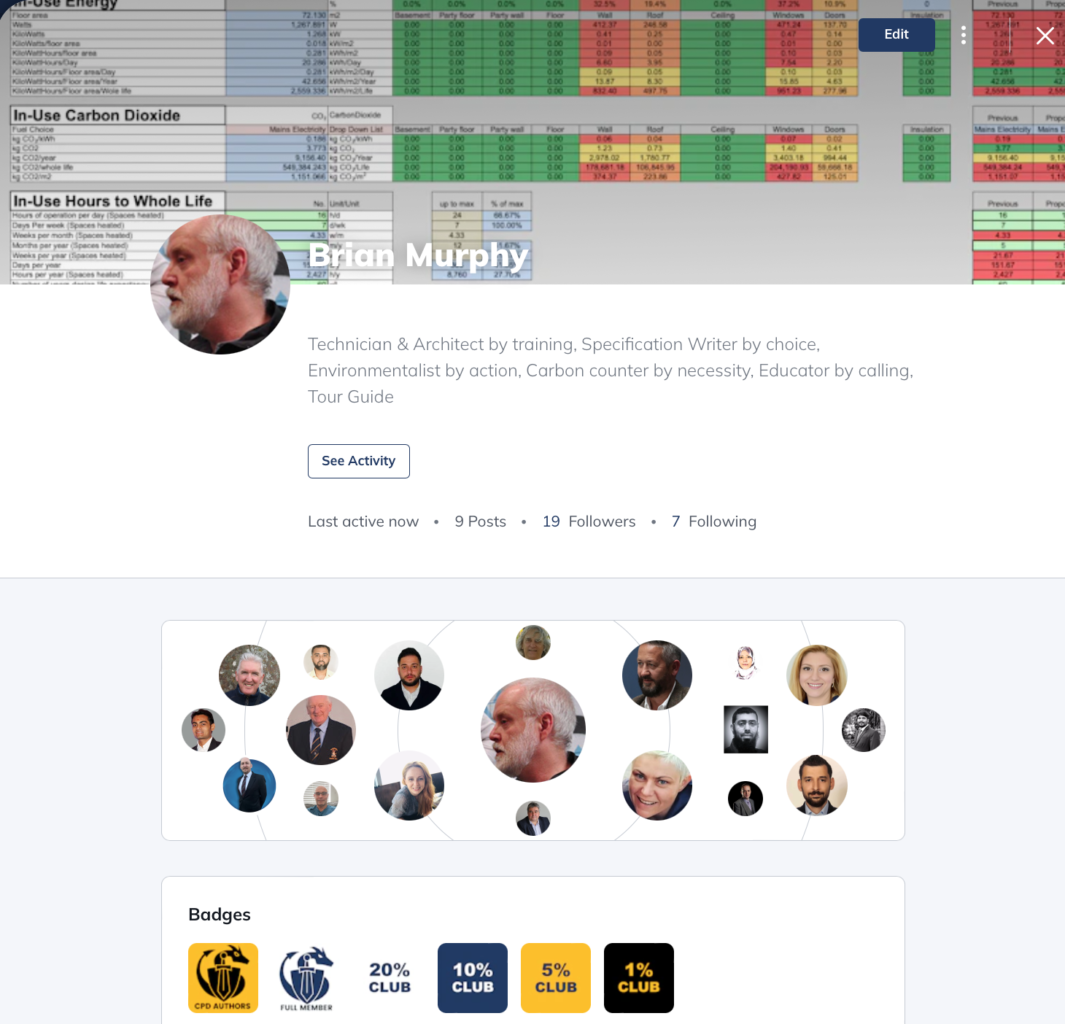
BIM Standards Sustainability BrainDump
GBE > Encyclopaedia > Code > BrainDump > G#41579
About:
Published in BIM Heroes platform
7.2 Standards & Sustainability CPD
“The Role of Value Standards in Sustainable Construction and Operation”
An “introduction” to relevant standards or AEC sector in relation to “sustainability” and the value they deliver.
Outline structure:
The BIM Heroes programme is looking at the relationship between “quality” (ISO 9001), “project management” (ISO 21500), “asset management” (ISO 55000), and “information management” (ISO 19650).
“Sustainability” is both a “quality” issue, and has an impact on the long-term asset value (particularly with regards to upcoming climate change initiatives, EU green deal etc.
How do these fit into “quality”, “project”, asset” and “information management”?
The sophisticated calculations and analysis required to determine and guarantee “green building” is highly dependent on “information”, as well as engaging the right people, at the right time.
It is very difficult to implement “green building” at a late stage.
What are the most important things AEC should consider?
GBE Green = HERACEY™
BrianSpecMan is a Technician and Architect by training, Specification writer by choice, Environmentalist by action, Website editor and Carbon calculator by necessity, Educator by calling, Tour guide for fun.
My perspective is with 50 years in construction, 40 years in specification, 24 years in environmental and 10 years building calculators; but always disseminating on joined up environmental thinking, challenging the establishment and business as usual.
See Also: BrianSpecMan https://GreenBuildingEncyclopaedia.uk/?p=896
 I prefer to dwell in environmental issues because sustainability is always compromised by bad economics, the way QSs run the show at the moment with:
I prefer to dwell in environmental issues because sustainability is always compromised by bad economics, the way QSs run the show at the moment with:
- Inadequate elemental cost planning,
- based on an outline specification, not updated at full specification,
- ignoring all the details, interfaces, etc.
- violet price books for conventional methods and materials, that lack granularity,
- no green methods or materials,
- ‘value engineering’ aka ‘cost cutting’,
- encouraging or causing substitution and surreptitious substitution
- helping to increase the “Performance Gap” between designed and actual performance.
In the absence of a really useable definition for Sustainability, Green Building Encyclopaedia uses HERACEY™:

Healthy Environmental Resourceful Appropriate Competent Effective Yardstick.
If your project is addressing these issues robustly in its materials and methods of construction choices, then it is probably sustainable.
See Also:
- Finance Gap (Opinion) https://GreenBuildingEncyclopaedia.uk/?p=41199
- Performance Gap (Opinion) https://greenbuildingencyclopaedia.uk/?p=41216
- GBE HERACEY™ (Jargon Buster) https://GreenBuildingEncyclopaedia.uk/?p=1429
BRE Green
Unfortunately, (formerly Building Research Establishment) BRE’s Environmental Assessment Method’s (BREEAM) reliance upon BRE’s Green Guide to Specification (GGtS) are our primary tools to ‘Green up our buildings’; are a long way from enabling “Green Building” as I understand it but helps perpetuate “Less Violet Buildings” and will continue to do so until “Green Materials and Green methods” and included.
It gets worse BRE’s GGtS perpetuates Business as Usual (BAU), is reliant upon carbon credits outside of the industry to get to greenwash Net-Zero and creates barriers to use of carbon sequestering biobased materials and methods to ever achieve low carbon materials and construction.
 GBE CPD BRE GreenGuide Green Materials Olympics PPSX
GBE CPD BRE GreenGuide Green Materials Olympics PPSX
See Also:
- Green Guide to Specification (GGtS) (Jargon Buster) https://GreenBuildingEncyclopaedia.uk/?p=1398
“BIM & BREEAM”
I have limited exposure to BIM, attending a few BIM events at BRE, BIM for Manufacturers and Manufacturing (BIM4M2), one about Digital Object Identifiers (DOI) and attending one and speaking at a second ‘Green BIM’ event in Leeds; another significant one called ‘Beyond BIM’ and I have presented about BIM twice from a specifiers perspective and lectured about BIM to Architecture students.
At the second Green BIM event I presented Cycle Assessment Procedure for Eco Materials (CAP’EM) an Interreg funded Life Cycle Assessment (LCA) and Environmental Product Declaration (EPD) methodology used initially to assess 100 eco materials before EN 15804 was developed.
Another Green BIM speaker mentioned that “If we did not have to do BREEAM we could have done a greener building”, this response is repeated on many projects including some I was involved in.
My most recent exposure to BREEAM was spending weeks calculating areas of materials to record what had been designed but not to use the results to change the specification, it was already too late to change anything, now that cost plan budget was in place and restricting everything that followed.
Emphasizing the need to engage with “Sustainability” at the earliest stage in a project (before bad cost planning prevents changing anything).
Another project planning to use timber construction would not get any BREEAM points unless we switched to concrete, because BRE GGtS did not have timber school building options; so we cancelled BREEAM assessment.
I hope GGtS got or gets better or we will be prevented from going low carbon by BREEAM and GGtS.


 See Also:
See Also:
- Green BIM Leeds Https://GreenBuildingEncyclopaedia.uk/?p=1867
- Green BIM 2021 Https://GreenBuildingEncyclopaedia.uk/?p=39585
- BIM4M2 Https://GreenBuildingEncyclopaedia.uk/?p=11309
- BIM at Napier Https://GreenBuildingEncyclopaedia.uk/?p=626
- Beyond BIM See Jargon Buster Collection (Shop) https://greenbuildingencyclopaedia.uk/?p=40448
- DOI Https://GreenBuildingEncyclopaedia.uk/?p=7314
- CAPEM (Project) Https://GreenBuildingEncyclopaedia.uk/?p=546
- CAPEM (Screenshots) https://greenbuildingencyclopaedia.uk/wp-content/uploads/2015/11/CAPEM-Compass.pptx.pdf
- LCA (Jargon Buster Theme) https://greenbuildingencyclopaedia.uk/?p=1338
- EPD (CPD) https://greenbuildingencyclopaedia.uk/?p=38719
Quality Management
My approach to “Quality Management” is “say what you do, do what you say and keep records to prove it”; don’t add any more procedures to your day.
The real challenge is to maintain the clients brief, not drop the batten at any stage of the process and not allow bad cost planning to erode their ambition to invest well in a building that performs well and facilitate their business, but now with extra focus on energy, carbon along with costs.
“Project Management”:
- Postman Pat seeing how fast it can be done on paper,
- Ignoring correct sequence and curing times forcing the adoption of high-chemistry fast-acting poor-environmental materials.
“Cost Management”:
- How cheap can we do it, legal minimum conventional construction, ignoring the green obligations and green ambitions, forcing the adoption of cheap high-chemistry materials.
- Cost plan not being reviewed between outline and full specification once we know the true scope of work.
Procurement Methods
These two disciplines Project Manager (PM) & Quantity Surveyors (QS) appear to be responsible for recommending the adoption of bespoke procurement methods:
- That make it cheaper still and/or speed up construction on larger projects.
- That hand over specification responsibility to builders who do not have the knowledge to do so.
- That complicate and inadequately resolve trade contractor interfaces and design responsibilities.
- Take an extra fee to ultimately reduce quality.
See Also:
- GBE Time-Gap (Opinion) https://GreenBuildingEncyclopaedia.uk/?p=41207
- GBE Finance Gap (Opinion) https://GreenBuildingEncyclopaedia.uk/?p=41199
“Asset Management”
Never having had anything to do with “Asset Management”, I can see opportunities, but what do I know?
- Government Soft Landings (GSL) or Soft Landings (SL) requiring design teams to be involved for several years after handover to ensure the building and its services are tested and commissioned correctly, operating at optimum performance and ensuring FM staff know how to maintain them.
- Post Occupancy Evaluation (POE) for occupants to feedback and help design teams to get the building working effectively.
- Digital Twins (DT) including updated as-built and updatable 3D model and specification information, potentially playing the role of CAD FM Operation & Maintenance Manuals (O&MM) without the hard copy.
- Managing & Occupying Buildings Sustainably (MOBS) one of the best resources to make a difference, sadly no longer available.
“Information management”:
- As a Specification writer and Carbon calculator I am acutely aware for the absence of and need for comprehensive competent information including: specification, test evidence, accreditations, method statements, maintenance data, LCA, EPD, Material Safety Data Sheets (MSDS) etc. for Apps to interrogate and process with many equations.
- Post Grenfell enquiry I know I need to be sceptical about any test evidence pre-Grenfell, we need manufacturers to be honest with themselves and get everything independently tested outside of the United Kingdom (UK) until UK test houses and United Kingdom Accreditation Service (UKAS) have got their acts in order.
- All datasets need to be proactively kept up to date, and in the ideal world all datapoints need to be search engines interrogating the origin data every time the dataset is accessed.
- Digital Object Identifiers (DOI) should help to keep track of the origin data, if DOI was/is adopted by Architecture Engineering & Construction (AEC) sector.
- Construction Operations Building Information Exchange (CoBIE) & Product Data Templates (PDT) tables always presented a problem for me since there are not enough cells to post any useful environmental data, EPD AMD A2 needing 126 cells alone.
- The best solution suggested by BIM for Manufacturers and Manufacturing (BIM4M2) was point one cell at an EPD inside a database,
- I would suggest the cell points at a machine-readable PDF EPD and/or PDF on websites using 301 redirects and/or DOI to maintain the connection.
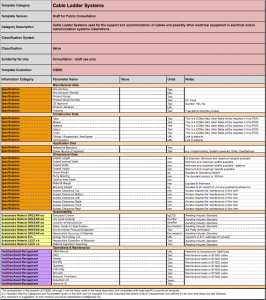
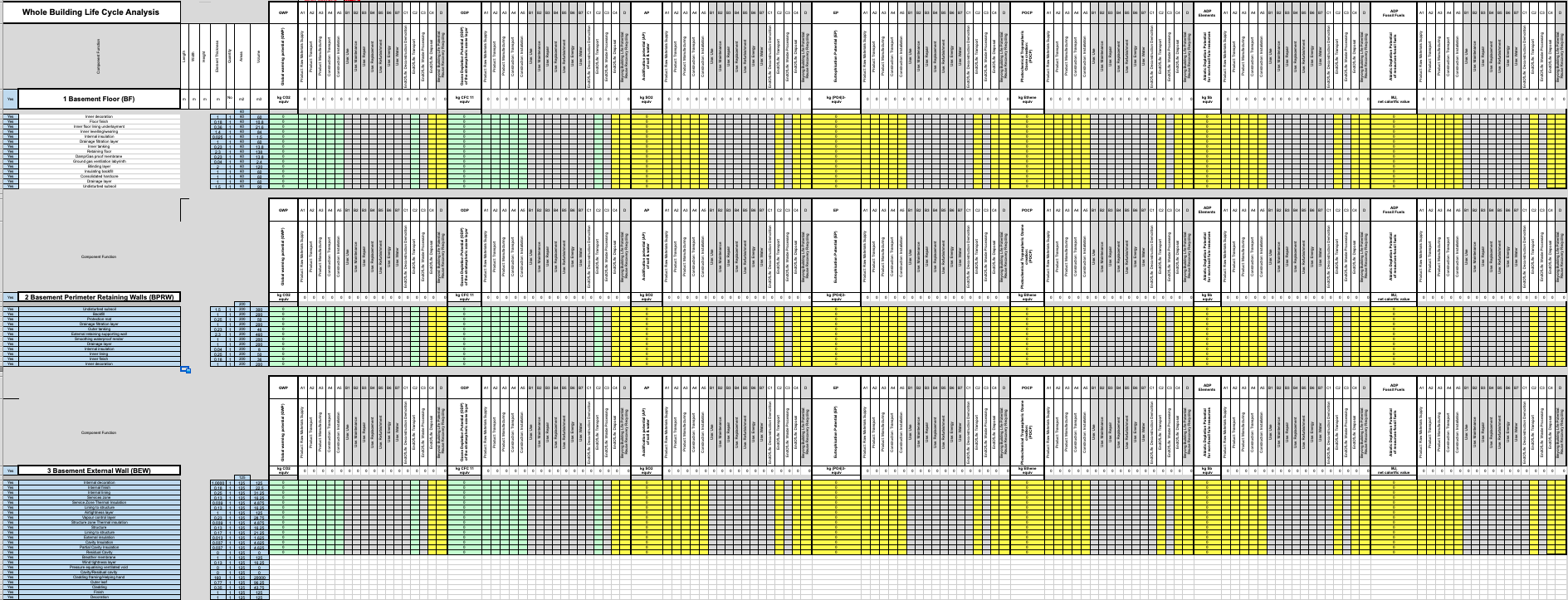
GBC Elemental LCA V2 A16 BRM 210121 PNG
See Also:
- Information Gap (Opinion) https://GreenBuildingEncyclopaedia.uk/?p=39241
- LCA (Jargon Buster Theme) https://greenbuildingencyclopaedia.uk/?p=1338
- EPD (CPD) https://greenbuildingencyclopaedia.uk/?p=38719
- DOI Https://GreenBuildingEncyclopaedia.uk/?p=7314
- PDT https://greenbuildingencyclopaedia.uk/?p=8097
- BIM4M2 Https://GreenBuildingEncyclopaedia.uk/?p=11309
Inevitably there is a need to address Whole Life Carbon (WLCO2) and Whole Life Costs (WLC) services that Designers and Quantity Surveyors (QS) are not offering these without an extra fee; the tools do exist but only in the hands of a few.
- Embodied carbon and sequestered carbon play a significant role in WLCO2 and need to inform our choice of materials and methods of construction.
- If we want to take Low or Zero Carbon seriously and avoid greenwashing with Net Zero Carbon, we have to radically reconsider material choices:
- No longer viable options: due to significantly high percentage of man-made CO2 comes from making these materials: (GBE Violet materials)
- Cement, Lime, Concrete, Steel, Aluminium, Fired Clay, Plastics, Chemistry.
- High rise using steel or concrete
- Future-proof and viable options with either zero or negative CO2: (GBE Green materials)
- Stone, Timber, Plant-based materials, Earth-based materials, Plant and Earth based materials,
- Highrise using Solid Wood Systems (SWS) Cross Laminated Timber Panel (CLT), GluLam, etc.
- Healthy Environmental Resourceful Appropriate Competent Effective Yardstick materials.
- A whole new world that we need to get up to speed on rapidly to the point we can confidently adopt them and promote them to our future asset owners.
 See Also:
See Also:
- Violet (Jargon Buster) https://greenbuildingencyclopaedia.uk/?p=1583
- Violet (Materials) https://greenbuildingencyclopaedia.uk/?p=963
- Green or Violet (CPD) https://greenbuildingencyclopaedia.uk/?p=408
“Beyond BIM”
BIM technologies have been available since the 70s, but the industry has been in perpetual accommodation for the past 40 years.
However we are now finally at the eve of adaptation (BIM level 2/3)…
furthermore we now have information technologies and a global data infrastructure that will accelerate us towards evolution allowing us to remake the industry in novel, but desperately needed, ways; transforming an adversarial self-serving Construction Industry into a low cost, low carbon Built Environment industry that sustainably serves society.
(Paul Fletcher 2012)
See Also:
- GBE BIM (Jargon Buster Theme) https://greenbuildingencyclopaedia.uk/?p=1409
- Beyond BIM See Jargon Buster Collection (Shop) https://greenbuildingencyclopaedia.uk/?p=40448
Continuing Professional Development (CPD):
- The author of this paper, GBE’s BrianSpecMan, has created and delivered over 1000 subject seminars related to Environmental Design, Specification and Procurement over the past 25 years.
- BrianSpecMan has also created and presented many lectures at University for RIBA Parts 1, 2 & 3 over past 17 years.
- In-house or on-line CPD seminars can be provided to update your team or inspire them into action.
- If you would like in-house or on-line CPD register your interest subject, date, time, location or deliver platform.
- My Zoom account or your MS Teams account or in your office
- Other BIM Heroes may provide BIM related CPD seminars too?
See Also:
- Booking: https://calendly.com/greenbuildingcalculator/gbc-cpd-or-lecture-request
- CPD (Navigation) https://GreenBuildingCalculator.uk/?p=7755
- CPD Topics (Navigation) https://GreenBuildingCalculator.uk/?p=472
- CPD Titles (Navigation) https://GreenBuildingCalculator.uk/?p=742
- Lectures (Navigation) https://greenbuildingcalculator.uk/?p=1081
BIM Heroes: Sustainability CPD
Part 1 Relevant Sustainability Standards:
Driving Reduced Carbon and other environmental improvements.
1 of 5
A word of warning
- Even Government & Non-Government Organisations (NGO) publications get it wrong sometimes, because of party political objective which may differ from the real needs; lobbying by interested parties, funding the party to get favours, bribes, etc.; first drafts are nearer the truth, but you will never see it, unless leaked.
- Even BRE misunderstand some issues and make statements that don’t appear to be questionable.
- AI written publications and articles may be used for marketing advantage but there is plenty of evidence that AI is a generalist when it comes to specialist subjects and AI is built on predominant business as usual published know-how unless briefed to do the opposite.
- AI will make mistakes; well informed humans can probably spot them and avoid or correct them.
Case Study: Question Everything:
- It is crucial to challenge the status quo, including ‘rules of thumb’ and ‘authoritative documents.’
- The commonly cited heat loss percentages for a building’s elements (walls, floors, roofs, windows) from sources like BRE and other authorities require deeper examination:
- When were these figures determined?
- On which Regulations or Design Guides are they based?
- Do they account for solar heat gains through glazing?
- Likely not.
- Do they consider heat losses due to glazing emissivity?
- Window technology has significantly advanced (U values from 5 to 0.5 over the decades)
- The building’s form factor and areas (whether it is boxy, linear, or has wings) greatly affect heat loss percentages no matter how high or low the U Value targets are.
- These percentages may not accurately reflect the current project’s or client’s investment, performance ambitions or needs.
- Exercise caution and do not accept guidance from authoritative documents as absolute truth without thorough scrutiny.
Case Study: Triple vs. Double Glazing
- The addition of a third pane of glass in a window may have a larger environmental impact (such as embodied energy) during its production compared to the energy savings it provides over the building’s lifetime (such as in-use energy).
- This can lead to a cognitive bias that discourages its use.
- However, this is not the complete picture.
- The exact specifications of the glass, gases, coatings, edge spacers, window frames, and installation methods can all affect the overall impact, either positively or negatively.
- Therefore, we should not accept simple statements as absolute truth and allow them to become cognitive biases.
- The improved temperature of the inner pane’s internal face makes it closer to the wall’s internal face temperature.
- This minimizes noticeable temperature differences, providing thermal comfort that reduces the occupant’s need to adjust the thermostat, significantly lowering in-use energy over the building’s lifetime.
See Also:
- Real Knowledge v Artificial Intelligence (Q+A) G#41921
- https://greenbuildingencyclopaedia.uk/?p=41921
Publications: Global
United Nations (UN) Sustainable Development Goals (SDG)
- 25th Sept 2015
- 193 world leaders committed to 17 Sustainable Development Goals by 2030
- RIBA have mapped SDGs to RIBA Stages of work
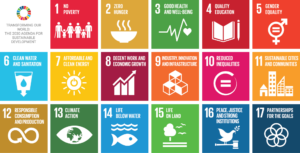
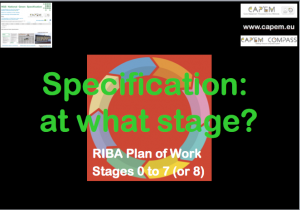
Specification starts at the beginning and goes on all the way through
See Also:
- Green Building Encyclopaedia Sustainable Rail UN SDG (Brain Dump) G#39377
- https://GreenBuildingEncyclopaedia.uk/?p=39377
- Specification Development RIBA Plan Of Work 2013 G#1339
- https://greenbuildingencyclopaedia.uk/?p=1339
BIM Heroine Merve Guven
- I started my abstract article about UN SGDs how to relate AEC.
- That is the abstract for now, I continue to search some articles and hope to improve.
See:
Global & National
World & UK GBC (Green Building Councils)
- World GBC Net Zero Carbon (NZC) Buildings Commitment by 2030 Sept. 2018
- UKGBC Net Zero Carbon Buildings:
- A Framework Definition: April 2019
See Also: GBE website
- Net Zero Carbon https://GreenBuildingEncyclopaedia.uk/?p=25511
- WGBC Bringing Embodied Carbon Upfront
- 2019 ‘Upfront Carbon’
- disconnecting from Operational Expenditure (OPEX) therefore ignores Total Expenditure (TOTEX)
- Whole life Value Engineering (WLVE) becomes more complicated, if it ever existed
- Budget March 2021:
- Government announcement: Build Back Better
- UKGBC observation and response: Build Back Business as Usual
- Net Zero Whole Life Carbon Roadmap for the Built Environment:
- March 2021
Engage with UKGBC NZC market’s ambitions:
- Carbon Tools: Objectives:
- Verification of carbon needed asap (Embodied and In-use)
- Quick, flexible first and improve over time
- Accessible for mass uptake
- Low cost, preferably free
- Wide access
- No monopoly
- Global Valency
- Applicable in many countries
- Metric and SI: UK, EU and International
- Imperial: USA and USA influenced countries
- Independent & Transparent
- Ideally visible open book calculators to enable learning
- Need to emphasize plant-based low carbon materials but include others for comparison
- Everything must be measured
- Bill of Quantities, Elements, Components, Accessories
- Not just design stage, at all stages Pre- and post-tender VE, Post-tender cost cutting and substitutions
- Verification Not Certification
- Not a rating tool, private and slow to launch
- Standards: Verification, lower cost and quick
- October 2023: NZC Postponed or dropped altogether by Conservative Government.
- 2024: Labour Party will no longer commit to funding green agenda if elected.
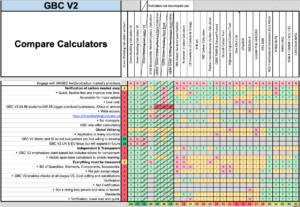 See Also:
See Also:
- Green Building Calculator for comparison of published carbon calculators
- https://GreenBuildingCalculator.uk
BIM Heroes: Sustainability CPD
Part 1 Relevant Sustainability Standards:
Driving Reduced Carbon and other environmental improvements.
2 of 5
European Union (EU)
Energy Efficiency Directive 2012/27/EU (EED) and 2018 update
- EU Directive 2012/27/EU as amended in 2018 sets rules and obligations for achieving the EU’s 2020 and 2030 energy efficiency targets.
- With the European Green Deal (not UK’s failed GreenDeal), the EU is increasing its climate ambition and aims at becoming the first climate-neutral continent by 2050.
- The European Commission (EC) has therefore revised the Energy Efficiency Directive (EED), together with other EU energy and climate rules, to ensure that the new 2030 target of reducing greenhouse gas emission by at least 55% (compared to 1990) can be met.
(EC website ’22) - (https://energy.ec.europa.eu/topics/energy-efficiency/energy-efficiency-targets-directive-and-rules/energy-efficiency-directive_en)
- EC are driving a reduction in-use energy of buildings; needing a radical response in levels of conductivity thermal insulation to achieve it.
- When thermal insulation levels increase across the board and reduce building in-use energy demands considerably; then the embodied energy in the materials used to build them, grows proportionately, hence choice of building materials and methods needs to be targeted.
- Low energy, Low carbon, Low chemistry and Low water materials including stone, subsoil, earth-based, bio-based and timber materials become very relevant in this quest.
2023 Energy Performance of Buildings Directive (EPBD):
- Introduced the “Fit for 55” legislative package.
- The proposal includes the following priorities:
- Obligation for all member states to establish National building renovation plans
- Establishment of Minimum Energy Performance Standards (MEPS), requiring the worst energy performance (non-residential) buildings to reach at least class F by 2030 and class E by 2033.
- Promotion of technical assistance, including one-stop-shops and renovation passports
- Introduction of new financial mechanisms to incentivize banks and mortgage holders to promote energy efficient renovation (mortgage portfolio standard)
- Following the outbreak of the war in Ukraine, the Commission issued additional proposals, such as the obligation to ensure new buildings are solar ready and to install solar energy installations on buildings.
(Wikipaedia ’23)
- The EPBD recast represents a comprehensive action plan to renovate the EU’s buildings, bring down energy consumption, reduce building-related emissions and reach a climate neutral European building stock by 2050.
- Embodied carbon is estimated to account for 10-25% of the total carbon footprint of buildings.
EC are driving a reduction in-use energy of buildings; needing a radical response in levels of conductivity thermal insulation to achieve it. - An especially welcome aspect of this EPBD recast is that it addresses embodied carbon and whole life greenhouse gas emissions (that is, both embodied and operational emissions).
- Until now, embodied carbon (EC) has remained largely ignored in the EU and the building sector’s efforts to reduce its carbon footprint.
With this EPBD recast, this is set to change.
- “This EPBD vote ensures several positive steps forward for decarbonising buildings, of which two are especially welcome to us: It will establish a harmonised framework for addressing and measuring whole-life carbon, and it will set targets for embodied carbon reduction”
- (Bellona ID ’23)
- “The EPBD recast represents a real opportunity to accelerate the emissions reduction trajectory for embodied carbon, and we expect to see the level of action that the Parliament has now called for maintained throughout trilogues”
- (Bellona MA ’23)
A strong EPBD is critical to reaching climate targets
- Buildings account for approximately 40% of the EU’s total energy consumption and 36% of its CO2 emissions.
- Meanwhile, three out of four buildings in the EU are still energy inefficient.
- The EPBD recast represents a comprehensive action plan to renovate the EU’s buildings, bring down energy consumption, reduce building-related emissions and reach a climate neutral European building stock by 2050.
- Embodied carbon is estimated to account for 10-25% of the total carbon footprint of buildings.
- Heavy industries such as cement and steel production account for a large portion of these emissions associated with the construction, renovation, and demolition of buildings.
- (EC ’23)
What the EPBD says about embodied carbon
- The EPBD recast sets out a requirement to both calculate and establish targets to reduce building related emissions throughout the building’s life-cycle.
- The European Parliament position on the EPBD that was voted on, calls for an EU-wide framework for calculating life-cycle Global Warming Potential (GWP), and for Member States to publish roadmaps that introduce limit values and targets on life-cycle GWP.
- Each Member State must develop national building renovation plans, including renovation targets suited to each country’s building stock and needs, and illustrate how these national targets are to be met.
- By calling for this, the EU is ensuring that high quality data on embodied carbon will be widely available to the myriad of actors in the buildings sector.
- Coupled with the clear signals provided by targets, this information could help trigger a scale-up of the production and use of low-carbon construction materials.
- In this sense, it is also important for the EPBD to be aligned with the on-going recast of the Construction Products Regulation (CPR).
- (Bellona Europe ’23)
2024 Energy Performance of Buildings Directive (EPBD):
The latest amendment to the recast Energy Performance of Buildings Directive (EPBD), approved by the European Parliament mandates significant enhancements in building energy efficiency across the EU. (Not UK)
Here are the key impacts and important dates:
New Real Estate:
– Zero-Emission Buildings (ZEB): By 2030, all new buildings must be zero-emission, characterised by high energy performance with the remaining energy demand met by renewable sources.
– Enhanced Building Codes: New constructions must comply with stricter energy efficiency standards, incorporating advanced technologies such as high-performance insulation, energy-efficient windows, and renewable energy systems.
The whole life-cycle emissions of buildings will be considered, starting with new buildings promoting sustainable building practices and materials from construction to demolition.
Existing Real Estate:
– When buildings undergo major renovations the energy performance of the building or the renovated part thereof is upgraded in order to meet minimum energy performance standards.
– Member states shall address, in relation to buildings undergoing major renovation, the issue of indoor environmental quality, adaption to climate change, etc.
– Member States shall introduce a scheme of renovation passports based on the common framework
Key Dates:
– January 2028: Public buildings must meet ZEB standards. (GBE: no not Net Zero Carbon)
– January 2030: All new buildings must be ZEB (GBE ditto)
– October 2023: United Kingdom (UK) Conservative Government abandon or postponed all ambitions
Financial Incentives and Support:
Increased financial incentives, grants, subsidies, and tax breaks are available to property owners to offset the costs of energy-efficient renovations.
Integration of Smart Technologies:
Encourages the use of smart technologies and automation systems to optimise energy use in existing buildings, including smart meters and energy management systems.
The EPBD aims to reduce carbon footprints, save energy costs, and improve living conditions, driving the EU towards a climate-neutral economy by 2050.
(BIM Heroes RM ’24 – GBE BRM ’24)
BIM Heroes: Sustainability CPD
Part 1 Relevant Sustainability Standards:
Driving Reduced Carbon and other environmental improvements.
3 of 5
UK Government
November 2023 Public Procurement Verification system
- Launched with Constructing Excellence (CE)
- Necessary because despite the rules nobody was doing it properly?
- The paperwork was too big a burden!
- Despite the thresholds, exclusions, declaring conflicts of interest, etc.
- Fast tracking friends, UK corruption was all possible, especially during COVID pandemic.
2021 UK Environment Bill
- Biodiversity increases by 10%
- 2030 All new Buildings must be Net Zero Carbon
- 2050 All existing building stock to be Net Zero Carbon
- 2023 All targets postponed or dropped by Conservative Government
Sustainable Government Procurement?
- Private Water Sector: Government driver:
- Focus on Total Expenditure (TOTEX) = Capital Expenditure (CAPEX) + Operational Expenditure (OPEX)
- Saving £m by looking at Whole Life Costs (WLC)
- Other Sector roll out? Nothing happening
- October 2023 UK Gov declining ambitions, highly unlikely it ever will.
- Now private enterprises water utilities are subject to fiduciary rules and many MPs and foreign investors being shareholders wanted more cash payouts.
- Permitted to take out loans to invest in infrastructure, not invest it, but give it away as profits.
- Direct to shareholders without improving services?
- The amount of money loaned (billions) matches the amount of shareholder payouts, not representing profits after a job well done.
- Government voted that water utilities can pollute waterways, waterbodies, beaches and seas with raw untreated sewage with associated flotsam, in dry conditions as well as rainy conditions associated with combined sewer overflows when excessive surface water drainage combines with foul sewerage.
- Heavily polluted rivers but gill breathing mammals and fish at risk of asphyxiation.
- Environment Agency are underfunded effectively nobbling their policing role.
- Once caught out and improvements demanded by public objections Water utilities claimed they will have to increase consumer bills to pay for improvements
- Enabling more income from consumers to be distributed amongst shareholders?
- Immediately after this issue identified (and resolved?) government voted to permit housing developers to pollute waterways.
- Housing developers share value skyrocket overnight, shareholders benefit.
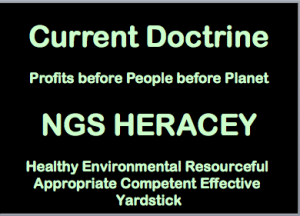
Current Doctrine v NGS Heracey(tm)
Government Procurement: Post-Brexit:
- EU Procurement Rules V2: No longer relevant to UK, except if exporting from UK to EU
- CE Mark Essential Requirements
- Environmental added:
- CEN Technical Committees TC 350 and TC 351 rolled out >
- LCA > EN 15804 > Product Category Rules > Impacts > EPD reports
- CE Mark replaced by UKCA for goods in UK Jan. ‘21
- Essential requirements still relevant: but aim at BSs not ENs?
- 2023 Conservative Gov. considering dropping UKCA after so much investment by UK industry.
- Green Public Procurement (GPP): Still possible if anybody could be asked.
- Office of Government Commerce (OGC):
- Gateway Process Reviews:
- More due diligence tick boxes than specification audit?
 See Also:
See Also:
- GPP https://GreenBuildingEncyclopaedia.uk/?p=1602
- EU Specification (Q+A) GPP Toolkit https://greenbuildingencyclopaedia.uk/?p=38130
- CE Mark: Proper materials (CPD) https://greenbuildingencyclopaedia.uk/?p=314
UK Government influences others?
- SuSStations: EU Interreg funded project
- Development of an Environmental Assessment Method (EAM) for railway stations
- https://greenbuildingencyclopaedia.uk/?p=916
- https://greenbuildingencyclopaedia.uk/?p=39377
UK Government Publishes, others join in?
- But is anybody in the industry reading them?
- Librarian or Knowledge Manager Yes:
- Directors and executives? No, everybody else is busy
- UK Government Commitment to Net Zero Carbon 2050
- ‘Construction 2025’: July 2013
- Committee on Climate Change: May 2019:
- The Construction Playbook: V1 Dec. 2020
- Procurement Policy Note PPN 02/21 WTO GPA & UK-EU TCA
- Infrastructure
- National Infrastructure Strategy Nov. 2020 CP 329
- Government Soft Landings (GSL) still there, being adopted.
‘Construction 2025’
- July 2013
- Industrial Strategy: Government and Industry in Partnership
- 33% lower costs
- 50% faster delivery
- 50% lower emissions
- Did anybody sign up to this madness?
- Was anybody consulted the industry?
- Ever optimistic and unrealistic PM & QS? Nobody else?
- Reductions on top of Constructing Excellence’s
- 10% year on year improvement challenge that has proved impossible
- The Construction industry is already effectively bankrupt: financially and morally.
- Supported by supply chain funding Main Contractors (MC)
- with 90+ days delay on payments to sub-contractors (SC)
- And severe mental stress
- And high suicide rates
- Despite paying lip service: signing up to health and wellbeing & modern slavery campaigns
- Supported by supply chain funding Main Contractors (MC)
Committee on Climate Change
- Committee on Climate Change: May 2019:
- Net Zero: The UK’s contribution to stopping global warming
- https://www.theccc.org.uk/publication/net-zero-the-uks-contribution-to-stopping-global-warming/
- https://www.theccc.org.uk/publication/net-zero-technical-report/
- Abandoned in 2023 by Conservative Government
See Also: GBE website
- Net Zero Carbon https://GreenBuildingEncyclopaedia.uk/?p=25511
The Construction Playbook V1 Dec. 2020
- Sourcing and contracting public works projects and programmes
- ‘Build Back Greener’
- But still no verification until launched in November 2023
- Just after All green ambitions postponed or dropped by Conservative Government
National Infrastructure Strategy Nov. 2020 CP 329
- Fairer Faster Greener
- COVID recovery
- Decarbonising & Climate Change Adaptation
- Investment plans
- Transport
- Tailpipe emissions ignoring mains energy generation and transmission inefficiencies and emissions
- Electric Vehicles (EV) infrastructure
- but Renewable Energy (RE) too?
- Energy
- More renewables % in mains electricity mix, is now better than Gas emissions
- But electricity is still more expensive option so switch over is less likely
- Buildings (27m homes)
- Green homes Grant
- Withdrawn April 2021
- Nature for Climate fund
- 30,000 hectares of trees/year
- To pay for Carbon Offsets and then get burned down by wildfires
- To replace HS2 devastation of specimen trees, ancient forest, Sites of Special Scientific Interest (SSSI)?
- It will take decades and centuries to replace trees and what they offered to nature
- Ancient Forest and SSSI cannot be replaced
- 10 Point plan for Green Industrial Revolution
- October 2023 Conservative Government abandoned Green Ambitions
See Also:
- Carbon Counting Calculators Environmental Infrastructure https://GreenBuildingEncyclopaedia.uk/?p=39287
BIM Heroes: Sustainability CPD
Part 1 Relevant Sustainability Standards:
Driving Reduced Carbon and other environmental improvements.
4 of 5
UK Government Commitment to Net Zero Carbon 2050?
- 2023 All EU obligations or promises made leading to Brexit are now dropped or postponed.
See Also:
National & Local Government
Who is setting energy or carbon targets?
- Development Control? Planning? Landowners? Funders? Insurers?
- Belgium set Passivhaus standard (thermal comfort and indoor air quality, in use energy and carbon)
- Northern Ireland set Net Zero Targets
- Scotland adopt Passivhaus standard.
- Somebody claimed that will cost £100,000 increase per house.
- Scotland postponed/cancelled Passivhaus (PH) requirement.
- Then like Association of Environment Conscious Building (AECB)
- AECB recalculated PassivhausPlanningPackage (PHPP) for UK climate and UK energy mix and created Carbon Lite Programme
- Scotland developed their own version of PH or PHPP to continue their campaign
- If you ask a violet builder to price a green building, they will start with the violet price then add on extras for greenness and a big safety margin for unfamiliarity; then substitute everything back to what they know and spoil everything.
- Grow green builders.
- But Government will not regulate building industry
- They tried recently with UK’s GreenDeal and again later
- The rich kids sipped champaign and patted themselves on the back and nothing happened.
- Building Control:
- Building Regulations Approved Document L In-use Energy (BRADL)
- But air leakiness will continue to erode energy performance.
- Building Regulations Approved Document Z Embodied Carbon (BRADZ) Still Pending.
- Industry campaigners even produced a draft Part Z
- Government objected on the ground of Copyright (IPR)
- And resisted, probably encouraged by speculative housing developed lobbying and funding
- Building Regulations Approved Document L In-use Energy (BRADL)
Climate and Biodiversity Emergency
- UK Government Signed up 1st May 2019
- Local authorities followed suit: without any idea how and scattered follow up action
- Extinction Rebellion (XR): frustration at lack of action by all governments
- David Attenborough’s Blue planet series.
- Architects Climate Action Network (ACAN)
- Greta Thunberg’s behaviour change campaign.
- Global call to adults to join school kids in protest marches September 2019
- Architects Declare: Oct 2019
- Construction Declare: Oct 2019
- Education Declare (a bit later?)
- but Architects Registration Board (ARB) and Royal Institute of British Architects (RIBA) are sleeping until October 2023
- ARB & RIBA finally woke up after Grenfell highlighted incompetence everywhere
- Universities won’t spend the students fee on expert speakers
- Proposal for £9000/annum fee over minimum 5 years will burden students for life or cohorts will dry up
- Structural & Civil Engineers Declare
- Interior Design Declare: March 2022
- Homeowners Declare via ACAN
Not the truth, not the whole truth and nothing but not the whole truth
- Dictatorship: Boris/Liz/Rishi & Home Office politicians: drive to outlaw all anti-government policy protest.
- Police instructed to use kettling and/or arresting thousands of peaceful protestors.
- One Extinction Rebellion (XR) Architect and peaceful protestor arrested and convicted ran the risk of being struck off for life by Architects Registration Board (ARB)
- ACAN protest outside ARB office seeking clarity on this issue; ARB “peaceful climate protestors will not be struck off”.
- Judges, instructed by politicians, to ban the whole truth: defendants not permitted to argue Climate Change drive their actions!
- Juries reminded by green advisers they can vote based on their own conscience, moral judgement and ignore the judge’s instruction.
- Some court cases thrown out by climate concerned jurors.
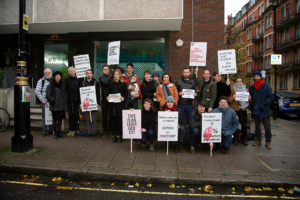
ACAN Showing Solidarity with Tom Bennett at ARB Office
See Also:
- Architects banned from Climate Protests? (Campaign) G#32802
- https://GreenBuildingEncyclopaedia.uk/?p=32802
Local
London Plan Whole Life-Cycle Carbon Assessment
- ADD2363 August 2019
- Operational emissions
- g. Heating, Hot water
- Embodied carbon are not currently measured
- Setting targets for Circular Economy (Reuse over recycling)
LETI London Energy Transformation Initiative (Campaign for better)
- Energy & Carbon in use and embodied
- Public consultation on Future Buildings Standard April 2021 & again March 2024
- Later renamed to put more emphasis on ‘Low’ less emphasis on ‘London’
Publications https://www.leti.uk/publications
19.04.23 Operational Modelling Guide
→ Download the Operational Modelling Guide here
13.03.23 Specification and Procurement Guide
→ Download the Specification and Procurement Guide here
06.03.23 Retrofit vs Rebuild Unpicker
→ Download the Retrofit Unpicker here
09.01.23 Embodied Carbon Case Studies
→ Download the Embodied Carbon Case Studies here
26.04.22 Circular Economy 1-pager
→ Download the Circular Economy 1-pager here
07.04.22 LETI-CIBSE Net Zero FAQs
→ Download the LETI-CIBSE Net Zero FAQs here
21.10.21 Climate Emergency Retrofit Guide
→ Download the Climate Emergency Retrofit Guide here
11.08.21 Client Guide for Net Zero Carbon Buildings
→ Download the Client Guide for Net Zero Carbon Buildings here
27.05.21 Whole Life Carbon One Pager
→ Download the Whole Life Carbon One Pager here
27.05.21 Embodied Carbon One Pager
→ Download the Embodied Carbon One Pager here
27.05.21 Embodied Carbon Target Alignment
→ Download the Whole Life Carbon One Pager here
10.02.21 Hydrogen: a decarbonisation route for heat in buildings?
→ Download the Hydrogen Paper here
27.01.20 Climate Emergency Design Guide
→ Download the Climate Emergency Design Guide here
27.01.20 Embodied Carbon Primer
→ Download the Embodied Carbon Primer here
16.12.19 Net Zero One Pager
14.03.19 Consultation on a Definition for Net Zero Carbon
14.02.18 Draft London Plan Consultation Response
20.09.17 Proposals for Energy Policy
03.07.17 Developing Policy for a Net Zero Capital
Government Soft Landings (GSL)
- Revised Guidance for the Public Sector
- on applying BS 8536-1:2022:Briefing for design and construction
- Part 1:2015:Code of Practice for Facilities management (Buildings Infrastructure)
- Part 2:2016:Code of Practice for Asset management (Linear and Geographical Infrastructure)
- Relates strongly with BIM Level 2
- PAS 1192 Series
- And Government Soft Landings (GSL)
- Freely available to download (Allegedly: but dead link from NBS)
See Also:
- Government Soft Landings (GSL) (Jargon Buster) G#1549 N#1490
- https://greenbuildingcalculator.uk/?p=1549
Continuing Professional Development (CPD):
- The author of this paper, GBE’s BrianSpecMan, has created and delivered over 1000 subject seminars related to Environmental Design, Specification and Procurement over the past 25 years.
- BrianSpecMan has also created and presented many lectures at University for RIBA Parts 1, 2 & 3 over past 17 years.
- In-house or on-line CPD seminars can be provided to update your team or inspire them into action.
- If you would like in-house or on-line CPD register your interest subject, date, time, location or deliver platform.
- My Zoom account or your MS Teams account or in your office
- Other BIM Heroes may provide BIM related CPD seminars too?
See Also:
- Booking: https://calendly.com/greenbuildingcalculator/gbc-cpd-or-lecture-request
- CPD (Navigation) https://GreenBuildingCalculator.uk/?p=7755
- CPD Topics (Navigation) https://GreenBuildingCalculator.uk/?p=472
- CPD Titles (Navigation) https://GreenBuildingCalculator.uk/?p=742
- Lectures (Navigation) https://greenbuildingcalculator.uk/?p=1081
BIM Heroes: Sustainability CPD
Part 1 Relevant Sustainability Standards:
Driving Reduced Carbon and other environmental improvements.
5 of 5
Part 1 Q&A
We hope you found this interesting, informative even enlightening but by no means comprehensive.
Which Directives, Regulations, Guidance, Advisory, Campaign documents listed here, if any, are helping you to make sustainability progress?
- List in comments
- Others not listed here, please record in comments
- I will investigate new to me items listed here to see if we make more progress.
Which documents listed here, or not, if any, are creating barriers to sustainability progress?
- List in comments
- Others not listed here, please record in comments
Are you and your business already making progress on your sustainability journey?
- Yes, its going well
- Yes, but very limited
- No, Clients are resistant
- No, there is no scope for sustainability
- Others not listed here, please record in comments
What are your organisations/project targets?
- Business as Usual
- Environmental
- Sustainable
- BREEAM
- UN SDG
- ESG
- Net Zero Carbon
- Low Carbon
- Zero Carbon
- Carbon Positive
- Biobased
- Circular Economy Circular Design
- Regenerative
- Practice Specific targets
- Others not listed here, please record in comments
What is the biggest barrier to progress towards your client’s project/organisation’s targets?
- Bad or violet Cost Planning
- No Legislative drivers
- Clients not interested in Greening
- Others not listed here, please record in comments
Do you feel you are equipped with sufficient signposts towards appropriate documents to get more involved?
- Yes, plenty
- No, need more detail (Read Part 2 of this CPD series)
- No, need more CPD (Read some of the See Also linked pages and documents)
- No, we need in house or on-line CPD to get our team motivated
- Please provide contact details to get in house or on-line CPD
- Others not listed here, please record in comments
Do you think being better informed will help with persuading Clients to engage
- Yes
- Government legislation or target dithering or yoyoing prevents persuading clients
- No
- Others not listed here, please record in comments
Do you feel Government could be doing more to encourage engagement?
- Brexit appears to be enabling Government to wriggle out of responsibilities
- Government publishes without apparent business consultation nor dissemination activity
- Government speaks with forked tongue, says one thing then acts differently
- Business Link like organisation could have helped with dissemination
- Supply Chain Sustainability School (SCSS) could help with dissemination
- Construction Industry Training Board (CITB) should help training skills
- We need to get on with it and ignore Government until it is updated to serve the majority.
- July ’24 update, it changed colour, let’s see if it can serve the majority and environment.
- Others not listed here, please record in comments
BIM Heroes: Sustainability CPD
Part 2 Sector Tools
Environment Sector Prepares
1 of 3
- LCA Life Cycle Assessment & EPD Environmental Product Declarations
- Method: Normalising to Euronorm (EN) 15804:2012, over last decade +Amendment (AMD) A1 2013 +AMD A2 2019
- AMD A2 became mandatory for EPD in 2022, therefor all EPD must be AMD A2 by 2027
- All new LCA EPD must be in AMD A2 format
- AMD A2 aligned EPD with European Commission’s PEF to avoid duplication
- Product Environmental Foot printing (PEF) because LCA EPD has been hijacked by the violets
- AMD A1 and AMD A2 EPDs are incompatible and should not be compared
- EPD platforms and carbon calculators need to be updated to AMD A2
- But most EPD are AMD A1 and all must be updated to AMD A2
- Manufacturers will update their EPD but generic materials might get left behind
- Manufacturer’s Associations/Federation may need to fund generic materials updates?
- Over a period likely to be 5 years long during which EPD are not comparable
- Plays into the violet’s ambition that EPD should not be compared
- Sequestered Carbon Method, outside of EN 15804 system boundaries
- Biogenic carbon is addressed by EN 16449:2014
- Manufacturers: 10,000 EPDs in market, plenty are in construction materials
- But most are AMD A1 and all must be updated to AMD A2
- 5 year cycle of regeneration as EPDs expire or products improve and manufacturers want to declare it
- LCA is a broader set of impacts, but we still need to focus on:
- Embodied carbon ≈ CAPEX Capital Expenditure
- Sequestered Carbon, Biogenic carbon, Timber and Bio-based materials, not Fossil carbon
- EN 16449:2014 (we might not be in EU but standards are private enterprise in United Kingdom (UK) but cited in regulations)
- In use carbon (IUC) ≈ OPEX Operational Expenditure
- Whole Life Carbon (WLC) ≈ TOTEX Total Expenditure
- Heathy building: Low chemistry, low plastics, low off gassing,
- Low embodied water and embedded water
- Platforms including OneClick LCA cannot show AMD A1 & A2 LCA or EPD datasets in the same place at the same time
- Many viewing platforms present A1 EPD
- Platforms are required to upgrade to an A2 viewing platform
- Currently many A1 EPD can be seen together,
- Very few A2 EPD exist but can only be seen with other A2 EPDs
- A1 and A2 cannot be seen together
- Until many A2 arrive A1
See Also:
- LCA (Jargon Buster Theme) https://greenbuildingencyclopaedia.uk/?p=1338
- EPD (CPD) https://greenbuildingencyclopaedia.uk/?p=38719
PAS 2080 Whole Life Carbon Assessment
- BSI British Standards Institute
- Publicly Available Specification (PAS)
- PAS 2080:2016 Whole Life Carbon Assessment
- The Green Construction Board (GCB)
- Guidance Document for PAS 2080
- Managing Whole Life Carbon in Infrastructure
- Roles and Responsibilities
- Process
- Introduction to LCA
- Case Studies
- Carbon Measurement Tools
- Rules for Calculations
- Sample datasets from many sources
Environmental Assessment Methods: Drive change?
BREEAM driven via GGtS & GBL
- Green Guide to Specification (GGtS)
- ‘BRE-Green’ not ‘GBE-Green’ Green Building Encyclopaedia (GBE)
- ABC ratings should be relegated to DEF and ABC are missing
- Industry average Generic Materials (no incentive to improve)
- 1200 Readymade Elemental Assemblies (probably not what you are doing)
- But exclude accessories
- High energy and high carbon metalwork and plastics
- So gives a completely false rating
- Bespoke assessments (BRE take their time)
- 400 more assemblies added? Still not green enough
- Green Materials missing
- Green Methods missing
- Low carbon materials and methods missing
- Negative carbon materials and methods missing
- Bio-based materials missing
- GreenBook Live (GBL) Products directory
- Previously mostly plastic or bitumen backed carpets (BRE Green!)
- BRE Environmental Profiles (EP) predating EN 15804
- = EPD once recalculated to EN 15804
BREEAM Infrastructure (Pilot)
- Like all BREEAM Tools
- it records what you did,
- not change the way you did it
- “If not from BREEAM, it could have been greener”
- High Speed Rail Link Phase 2 (HS2) destroys easy targets (whilst COVID lockdown hid evidence)
- Many Sites of Special Scientific Interest (SSSI)
- Many Ancient forests
- 400-year-old free standing specimen tree felled for a maintenance slip loop road
- designed at 1:50,000 scale that should have been rerouted 100 m at 1:1 scale
- BREEAM completely fails on behaviour change.
- BREEAM with Green Guide to Specification: completely fail on low carbon construction
CEEQUAL 6 Civil Engineering Environmental Assessment Method: Drive change?
- Previous CEEQUAL V5
- 15 years, 1300 trained assessors,
- now belongs to BRE
- + BREEAM Infrastructure Pilot
- = CEEQUAL 6
- June 2019,
- + Whole Life Carbon
- https://www.ceequalonline.com/login/
- Must be trained to use it.
- Cannot even see it until in training.
- Video Thank you BRE, link will not work
- Fee: £3000 (£3m)-£38,000 (£1000m)
Railways England?
National Rail Design Standards
- National Rail Specification? Nothing yet
Highways England:
Department of Transport (DoT) Standards
- National Road Specification?
- Guidance:
- Missed opportunity?
- No promotion just updated and reissued
- Example recycled content permitted, but nobody knew
- What about embodied carbon? Nothing yet
Missed past opportunities:
- WRAP’s Aggregain website: no longer funded, so gone.
- But some of WRAP outputs addressed recycled content, emphasised higher % over competency.
- Earth Exchange website: exchanging clean subsoil between sites, also gone.
Institute of Civil Engineers (ICE)
ICE Inventory of Carbon & Energy ‘ICE database’
- BSRIA Guide Version 2, 2011
- V3 remains free access
- 2019
- Many more materials Embodied derived from consistent method LCA
- More Infrastructure & Civils Datasets
- Haulage and transport datasets
- Less Energy datasets
- Update funded by infrastructure:
- Heathrow, Rail Safety & Standards Board (RSSB), Environment Agency (EA)
- https://circularecology.com/embodied-carbon-footprint-html
- But needs a lot of mathematical gymnastics to use the data and be able to compare side by side
See also:
- Green Building Calculator (GBC) (below) has done the gymnastics https://GreenBuildingCalculator.uk
- BSRIA GUIDE Version 2 https://GreenBuildingEncyclopaedia.uk/?p=1018
Highways England Carbon Tool
- Guidance
- July 2020
- Version v 2.3
- Excel On-line tool
- g. Schedules for data collection
See Also:
- GBE Carbon Counting Calculators (CPD) https://GreenBuildingEncyclopaedia.uk/?p=39145
- Carbon Counting Calculators Environmental Infrastructure https://GreenBuildingEncyclopaedia.uk/?p=39287
Life Cycle Analysis of Transport
- Impact of road and rail transport in LCA
- Flights are very carbon and energy inefficient
- Ships are very efficient
- Rail is very efficient
- Road is worse
- Big trucks are better than small vans
- Role of consolidation centres
- Long haul in big trucks or trains
- Pallet services remove many small vehicles off road
- Needs less drivers
- Lorry Driver working practices Directive reduced numbers of driving hours overnight
- 120,000 too few drivers, consolidation centres had to happen
- Switch goods to smaller trucks in consolidation centres
- Short haul in small trucks for easy access
- Round robin journeys: site <> consolidation centres
See Also:
- Green Insurance Repair Calculator (GIRC) (below) for Transport of materials, plant, waste and labour
- https://GreenBuildingCalculator.uk
Institute of Structural Engineers (ISE)
- The Structural Carbon Tool
- Launched: March 2021: Free to use
- Building Structure only
- (more parts of building possible to be model with endless hours of user effort)
- SCORS:
- https://www.istructe.org/IStructE/media/Public/TSE-Archive/2020/Setting-carbon-targets-an-introduction-to-the-proposed-SCORS-rating-scheme.pdf
- Embodied carbon:
- https://www.istructe.org/IStructE/media/Public/Resources/istructe-how-to-calculate-embodied-carbon.pdf
- Sequestered Carbon:
- https://www.istructe.org/IStructE/media/Public/TSE-Archive/2021/Timber-and-carbon-sequestration.pdf
See Also:
BIM Heroes: Sustainability CPD
Part 2 Sector Tools
Environment Sector Prepares
2 of 3
Mechanical Electrical Public health (MEP) Services Carbon Accounting
- GBE gave CPD Seminar to CIBSE EofE on LCA and Carbon accounting 2013
- A decade before TM65 & TM66 projects, NGS was prompting need for engagement asap
See Also:
- CIBSE EA Services EE EC LCA BIM (CPD) https://greenbuildingencyclopaedia.uk/?p=1106
- https://greenbuildingencyclopaedia.uk/wp-content/uploads/2014/04/NGS-CPD-Services-EE-EC-LCA-BIM-CIBSE-S92.pdf
BSRIA carbon accounting for services:
- Rules of engagement
- Topic Guide TG3/2012
- Metals and Plastics (High embodied energy and carbon)
- Sections: for materials
- duct simplicity: duct wall and framing/supports
- cable complexity: conductor wire or cable geometries, interstices spacers, sleeves, armour, sheathing,
- Components & Accessories: Valves, Controllers, kit, plant, vessels, wiring, insulation, labelling
- Circuit boards:
- Extremely complex, time consuming to calculate materials and impacts
- Industry sector wide solution needed: total sector impacts/circuit board mm2
- Circuit board generic material values/mm2
- Single issue focus is not helpful unless it is all brought together in one place.
- UKGBC ambition: Measure everything
CIBSE Calculator & Templates
- TM65 Carbon calculating in Mechanical, Electrical, Public health services
- Rules of engagement
- Plans for data collection and dissemination:
CIBSE Data Collection project
- 1 Domestic building generic datasets (pipes, cables and kit)
- 2 Non-Domestic generic datasets (pipes, ducts, cables and kit)
- 3 Domestic products specific datasets
- 4 Non-Domestic product specific datasets
- Well underway if not substantially complete
- TM66 Lighting
Professional – Practice
Royal Institute of Chartered Surveyors (RICS)
- RICS Professional Statement
- Whole Life Carbon Assessment for the built Environment
- Calculation methodology
- Edition 1 Nov. 2017
- Elemental Assemblies
- Relates to elemental cost planning
- Relates to Spon/Laxton/BICS
- Not confident this helps anybody
- Bad Cost planning?
- Especially in Infrastructure projects
- Bankrupt construction industry? Financially and morally
- Crippled Supply chain?
- Late payments more than 90 days?
- Mental Stress prevails?
- Suicide rates are high.
- Public consultation 2023
- Listened to Violet sector looking after its interests
- Over complicated carbon sequestration to point it cannot practically be taken into account
- Is effectively abandoned timber as a solution to climate crisis
- But despite that architects that care and know better, do better.
- Edition 2 February 2024
- More detailed, more solutions and more challenging
- Reporting table: Includes but makes sequestered carbon difficult to address
- Despite EN 15804 setting a consistency standard for all countries
- RICS makes LCA EPD inconsistent with other countries LCA EPD outputs
- Violets have their way again; nothing can be compared.
- Relates to elemental cost planning
See Also:
- January 2022 Public consultation GBE Evidence https://GreenBuildingEncyclopaedia.uk/?p=40205
- GBE Finance Gap (Opinion) https://GreenBuildingEncyclopaedia.uk/?p=41199
RICS training in WLCO2 Assessment
- If anyone is interested, RICS are doing a 3-part series training on Whole-Lifecycle Carbon Assessment.
- See here: https://www.rics.org/training-events/online-training/scheduled/rics-global-introduction-to-whole-life-carbon-assessment-3-part-series
- Whole life carbon assessment for the built environment, (“WLCABA”) RICS, PROFESSIONAL STANDARD, Global, 2nd edition, September 2023 including:
- Whole life carbon assessments A guide for clients.
- Global harmonisation of whole life carbon assessments
- Capacity building playbook for a sustainable built and natural environment.
- National playbook for implementing whole life carbon assessments.
Contracts & Procurement:
- Government does not want to collect enough tax from big business and wealthy individuals so introduced a different way to pay for infrastructure and buildings:
- Private Finance Initiative (PFI) or Private Public Partnership (PPP)
- Letting private Contractors build and private Facilities Management (FM) enterprises make £ millions, maintaining them for 25 years then handing the buildings back to Government.
- If a bid can cost a £1m in professional fees there has to be a major incentive to make a bid.
- So lucrative that most Constructors expanded into FM others gave up contracting and converted to FM enterprises.
- Very little joined up environmental thinking.
- Weak on specification and failed to control impacts of materials choices.
- Short life materials and 25-year long-life warranties and premiums to pay: the straw that breaks the camel’s back, helping to bankrupt UK National Health Service (NHS).
- Failure Case studies:
- 50 km (per hospital) of capped and coved Poly Vinyl Chloride (PVC) skirtings that fails when the phthalate plasticisers in the PVC polymer migrates into the adhesive immediately destroying its ability to stick, creating voids for bacteria to reside in, inside brand-new hospitals.
- Or building school with external masonry cavity walls without wall ties.
- Or building with Reinforced Autoclaved Aerated Concrete (RAAC) floors and roofs,
- Unreinforced Autoclaved Aerated Concrete (AAC) is used to make insulation concrete blockwork
- Aerated Concrete (AC) is used insulated ground bearing floors
- The latest thinking is that PPP will help to fund replacement of RAAC, which probably was adopted for the first time in PFI or PPP projects in the first place.
- Initial applications for RAAC were precast insulating wall panels carrying its own self weight and where an external rainscreen cladding with waterproof membranes and internal lining with vapour barriers may have been used.
- PFI school contractors appear to have adopted RAAC in place of Precast Reinforced Concrete planks as a loadbearing floor or roof; where its moisture permeability makes it vulnerable to leakage wetting, reinforcement corrosion and frost damage, all predictable issues.
- If thorough and competent scrutiny of the specification had occurred, this should have been avoided.
- But bad violet cost planning probably forced the hand and there was little will to veer away from low costs.
- PFI and PPP is superseded by a better system in Scotland.
See Also:
- Principles of Element Design (CPD) https://GreenBuildingCalculator.uk/?p=2084
- GBE Building Envelope Principles (Lecture) https://GreenBuildingCalculator.uk/?p=31815
Practice
Sustainable Engineering Specification?
- Engineer’s use Specification Templates
- Who maintains and updates the template with current good practice, new materials development
- How often is it updated?
- May well need a radical update to keep up with cement and concrete low carbon developments
- New cover for each job
- List all materials and techniques Green and Violet
- Permit greener options but do not require it.
- Little or no editing to be job specific.
- Rely on drawings to specify which, where.
- Are the Engineers getting Continuing Professional Development (CPD) seminars to keep them up to date with the specification template?
- Can they tell the difference between green and violet?
- Are they choosing low impact or being pushed by Professional Indemnity Insurance (PII) towards Business As Usual (BAU)?
- Are they choosing what they know?
Materials
Concrete Mixing Plants
- Have two cement silos.
- Ordinary Portland Cement (OPC) & Ground Granulated Blastfurnace Slag Cement (GGBS)
- waste from iron ore from steel production
- GGBS is significantly lower Carbon than OPC
- GGBS is lower cost than OPC
They save money by blending:
- OPC and GGBS
- A slower set but same ultimate strength
- Just enough GGBS so you won’t notice
- OPC drives GGBS hydration to maintain 7 & 28 day strengths
- Colour difference: OPC: cold grey, GGBS: Warm grey.
- As UK steel production shrinks GGBS will become rationed.
BIM Heroes: Sustainability CPD
Part 2 Sector Tools
Environment Sector Prepares
3 of 3
Green Building Calculator (GBC) (by the author of this article)
- In the absence of career competent architectural education there is a need for design and decision tools to fill some of the gaps.
- In the post-Grenfell world with the impending Regulation tsunami demanding competence not just awareness.
- It’s no good just doing scattered carbon calculations for parts of the building:
- Structural Engineers doing frames and slabs
- Façade Engineers doing cladding and curtain walling
- Architects doing building fabric
- Interior Designers doing finishes and furniture
- Service Engineers doing Mechanical Electrical & Plumbing
- Landscape Architects doing hard, soft and wet landscapes
- Civil Engineers doing Infrastructure
- And loads being missed out because somebody assumed the other was doing it
- See UK GBC NZW Low CO2 ambition above
- We need to become carbon-literate and chemistry-literate to be able to intuitively make environmental and healthier choices.
- Calculators need to address:
- winter heating and summer overheating, and future facing
- form factor,
- Choose and apply: legal minimum regulations v design standards v campaign targets
- U values of all elements, and sub-elements, new build and retrofit
- Competent appropriate materials offered in all applications
- k value, density, specific heat capacity, format and competent application of insulation materials
- Condensation check
- From hours of conditioning (heating or cooling) through to design life
- (normal = UK 60 years = EU/INT 50 years)
- Fuel choices, carbon factors and fuel costs
- Energy, carbon & cost of building and energy, carbon & cost in use
Green Retrofit Calculator (GRC)
- In addition to GBC features:
- Ready-made house types: based upon UK English and Scottish House Condition Survey and accommodate variations
- Survey form for other buildings and bespoke
- Elemental U values for existing, previous and proposed interventions
- Risk assessment based on existing building, previous and proposed interventions
- Scenario comparison: Existing + Previous interventions + New Interventions + Options & Alternatives
Green Interior Calculator (GIC) (proposed for development)
- In addition to GRC features:
- Furniture types and bespoke furniture
- Carbon (EPD) and Chemistry (MSDS) analysis of materials
Green Insurance Repair Calculator (GIRC) (proposed for development)
- In addition to GRC features:
- Scope 3 Carbon emissions in supply chain
- Emissions for labour, plant, materials, waste, vehicles
Other ambitions include:
- Glazing, Flooring, MEP Services, Landscape, Infrastructure, etc.
See Also:
- I wish carbon counting was easy, it is now https://greenbuildingcalculator.uk/?p=40692
- https://GreenBuildingCalculator.uk
- Durability Gap (Opinion) https://greenbuildingcalculator.uk/?p=41218
- Information Gap (Opinion) https://greenbuildingcalculator.uk/?p=39241
Continuing Professional Development (CPD):
- The author of this paper, GBE’s BrianSpecMan, has created and delivered over 1000 subject seminars related to Environmental Design, Specification and Procurement over the past 25 years.
- BrianSpecMan has also created and presented many lectures at University for RIBA Parts 1, 2 & 3 over past 17 years.
- In-house or on-line CPD seminars can be provided to update your team or inspire them into action.
- If you would like in-house or on-line CPD register your interest subject, date, time, location or deliver platform.
- My Zoom account or your MS Teams account or in your office
- Other BIM Heroes may provide BIM related CPD seminars too?
See Also:
- Booking: https://calendly.com/greenbuildingcalculator/gbc-cpd-or-lecture-request
- CPD (Navigation) https://GreenBuildingCalculator.uk/?p=7755
- CPD Topics (Navigation) https://GreenBuildingCalculator.uk/?p=472
- CPD Titles (Navigation) https://GreenBuildingCalculator.uk/?p=742
- Lectures (Navigation) https://greenbuildingcalculator.uk/?p=1081
Part 2 Q&A
We hope you found this interesting, informative even enlightening but by no means comprehensive.
Which Directives, Regulations, Guidance, Advisory, Campaign documents listed here, if any, are helping you to make sustainability progress?
- Others not listed here, please record in comments
- I will investigate new to me items listed here to see if we make more progress.
Which EU publication will provide incompatible outputs until 2027?
Which UK publications have the potential to prevent adoption of low carbon construction and materials?
ICE Database: which version is the current version?
Which Technical Memorandum are addressing services impacts
Which UK publication drives UK towards inconsistency with other countries outputs?
© GBE GBC GRC GBL NGS ASWS Brian Murphy aka BrianSpecMan ****
5th February 2024 – 9th July 2024




